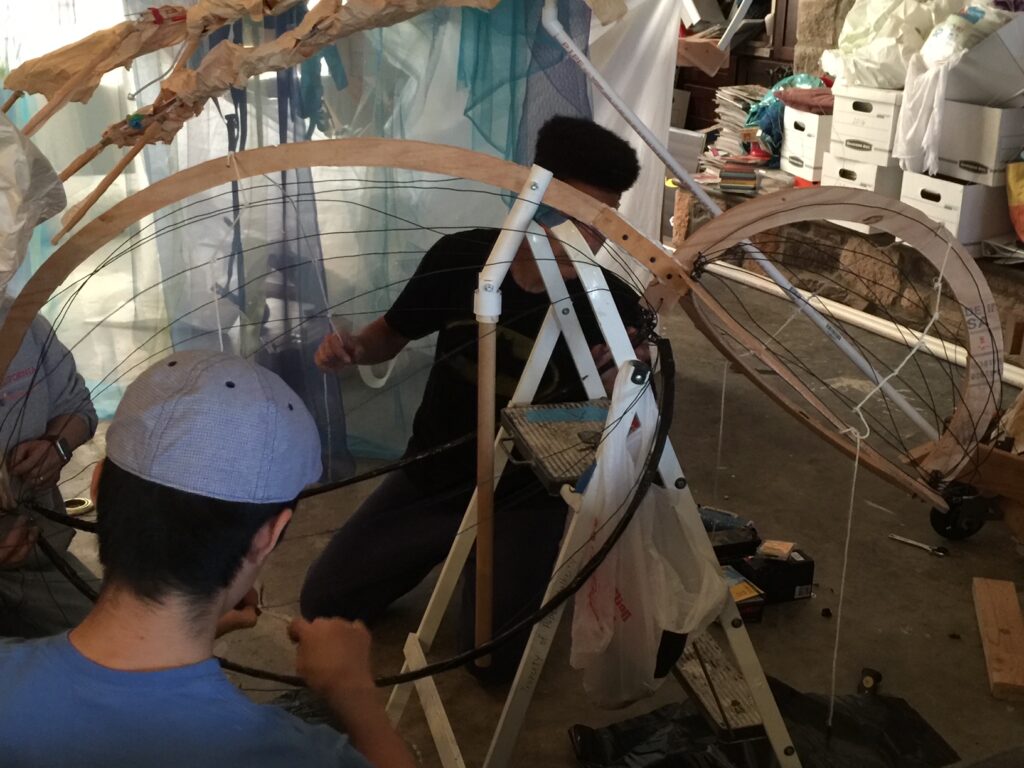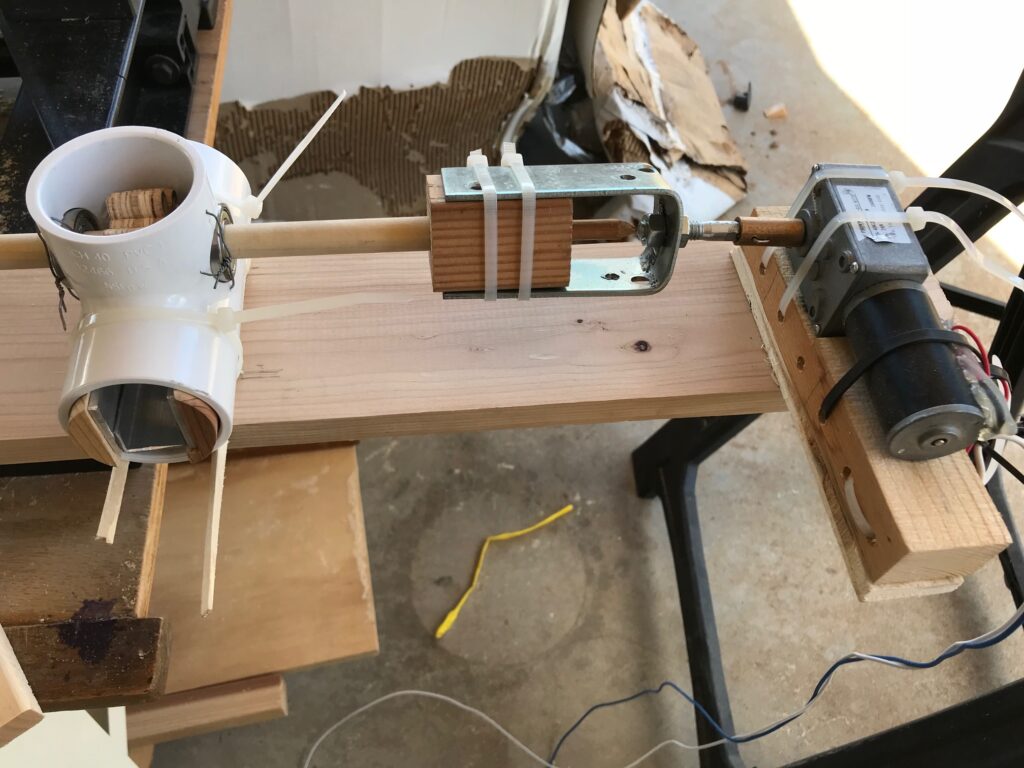Destination Imagination (DI) is a global non-profit organization that teaches children of all ages about STEAM (Science, Technology, Engineering, Arts, Mathematics) principles and encourages 21st century skills such as critical thinking, creativity, problem solving, perseverance, and teamwork.
The program is made up primarily of two components: Central Challenge and Instant Challenge. The Central Challenge is a long term, open ended challenge that teams spend months working on. There are six different Central Challenges that the teams have to choose from. Each Challenge has a different focus (Technical, Scientific, Fine Arts, Improvisation, Engineering, Service Learning), but have common requirements, as well. The Instant Challenge (IC) is a quick 5 minute challenge that teams are presented with, and have no prior knowledge of. The IC fosters teamwork and makes teams think on their feet in a very short period of time.
My Experience With DI
I participated in DI for 11 consecutive years with a variety of teams (2nd through 12th grade), but have always competed in the Technical Challenge. I have always been the primary designer/builder for each of my teams. Over the years my builds have increased in complexity, starting with a simple inverted remote control car that was used like a conveyer belt, to building large scale machines using circuit boards, gears, stepper motors, servos, rack and pinion linear actuators, and much, much, more. Although the challenge would change every year, one thing remained constant. A limited budget (typically $175) required creative thinking to come up with innovative, low cost solutions. Over the 11 years of competition, my teams have won numerous awards at the Regional, State, and Global level. DI has always been one of my favorite extracurricular activities. I now volunteer as an Appraiser for Regional and State tournaments.
Here are examples of some of my favorite builds. Hope you enjoy taking a look!
Show and Tech Stage

See the evolution of this build that started as a single boom arm that could lift an adult, to a complex “stage” that could lift a person while lowering panels over him to change the backdrops of a scene.
This is the rear view of the “stage” that houses all of the machinery, including winches, pulleys, motors, counter weights, and batteries.

Boom arm lifting me over 10 feet! 
Adding the structures to support the backdrops 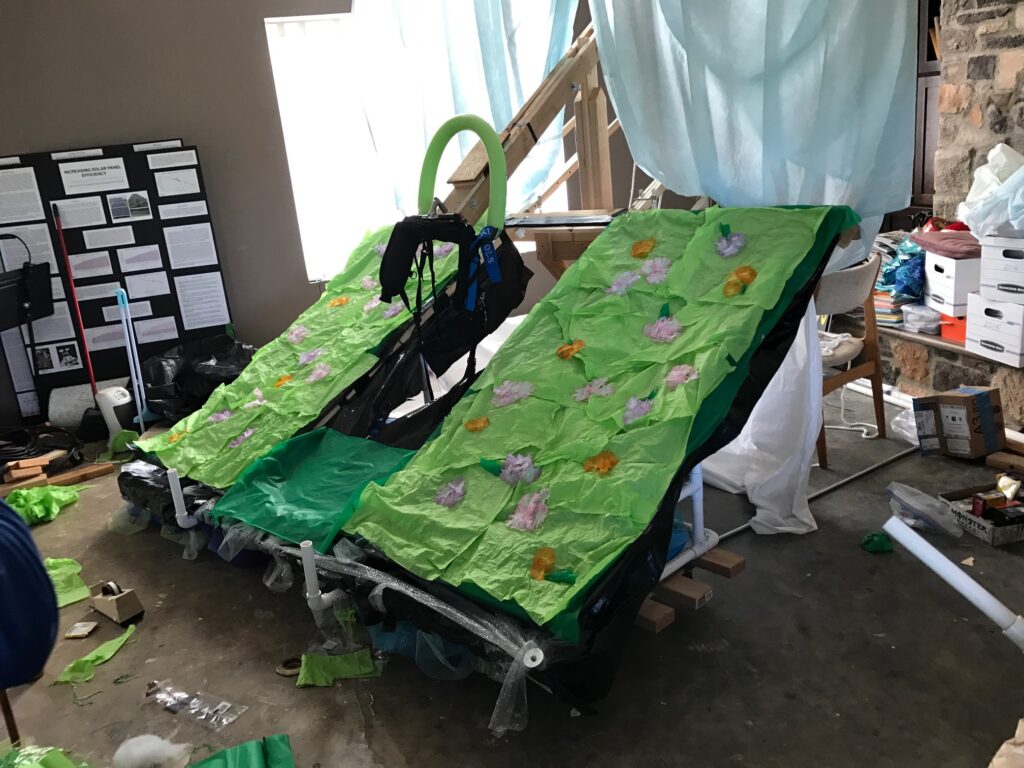
Grassy meadow scene 
Testing the undersea scene 
Trapped in a spider web! 
Actual performance at Global Finals!
Assembling the boom arm “stage” at Global Finals

Explaining the mechanics of the boom arm/stage to the Appraisers at Global Finals
The Amazing TSJ
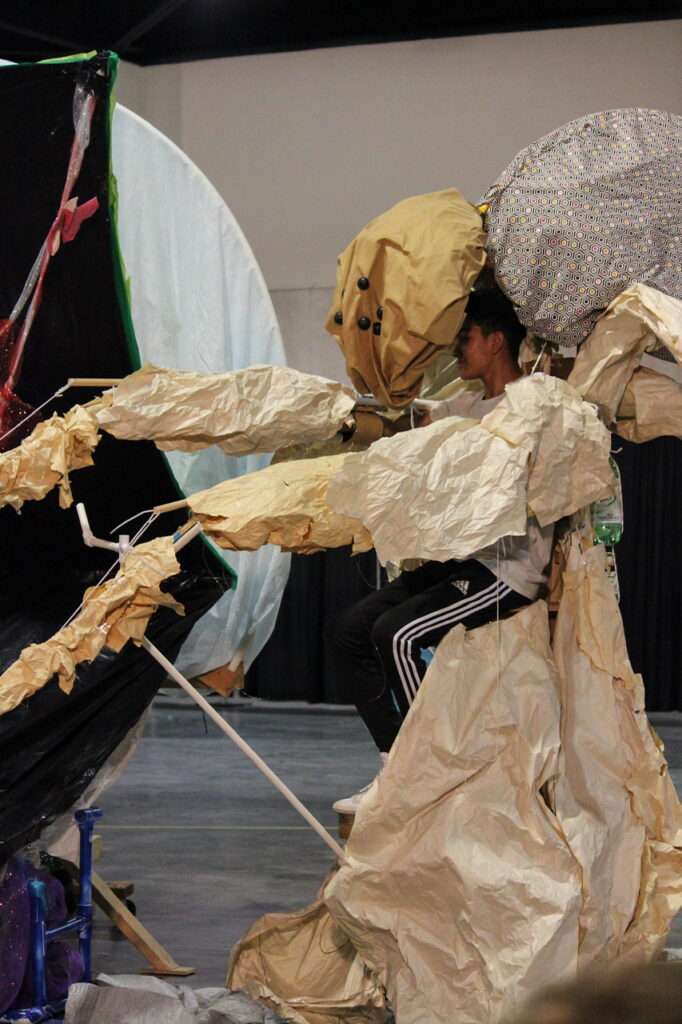
Another fun build for the same DI challenge was the TSJ (Tree ~ Spider ~ Jellyfish). This “creature” transforms during the performance from a tree, to a spider, and finally to a jellyfish along with the corresponding scene changes.
The TSJ is mobile, has articulating appendages, and the top branches of the tree transform to the body of a spider and jellyfish.

The “skeleton” of the TSJ appendages were built similar to the anatomy of a human arm. There are universal joints at the “shoulders” for rotational movement, and simple articulating joints at the “elbows” and “fingers”. The “bones” were made with wood and PVC. String, elastic cord, and springs made up the “muscles”. Similar to puppeteers controlling large-scale figures, the movements of the TSJ appendages were controlled by the team member’s arms, fingers, and feet.
Scooter motors and wheels were used to make the TSJ mobile. Eventually the throttle controls were placed in the tree branches for easy hand access. The reverse mechanism was controlled with the rider’s feet.
The frame for the top branches, spider body, and jellyfish bell were constructed with curved wood pieces and wire based on an accordion or folding fan design so that it could be folded up and disguised as tree branches. When the tree branch coverings are removed and the “accordion” released, the spider’s head and body are revealed. For the underwater scene, the structure is turned around and the covering of the spider’s body is removed to reveal the jellyfish bell. We used the Japanese art of “hikinuki” (pull and remove) for the quick change of the spider to the jellyfish. A thick basting thread is quickly removed and the fabric panels of the spider body are pulled off.




Appraisers inspecting the TSJ after the performance at Global Finals
The Maze Traveler

This DI challenge was called Maze Craze, and teams were required to build a device that could travel through a randomly generated maze. The story behind our performance is about a lost memory (the Maze Traveler) that is traveling through the brain. The “Brain Busters” are hired to retrieve the memory before it is lost forever.

The original Maze Traveler is pictured here. The wheels were cut out of plywood, and the electronics were housed in the box between the wheels.
We hacked into the electronics of a remote control car’s circuit board which was hooked up to 2 motors. One motor was hooked up to the forward/backward controls, and the second motor was hooked up to the steering controls. This allowed the two motors to be controlled separately, resulting in the Maze Traveler being able to turn on a dime.
Upgrade #1: In order to get the Maze Traveler to move faster, a second gear was added to decrease the gear ratio. This resulted in the wheels turning faster while using the same motors.
Upgrade #2: By hacking into the actual remote control, I was able to create a wearable device that uses finger connections to control the movement of the Maze Traveler.

The final version of the Maze Traveler successfully navigated the maze at Global Finals!
The Shrink Ray
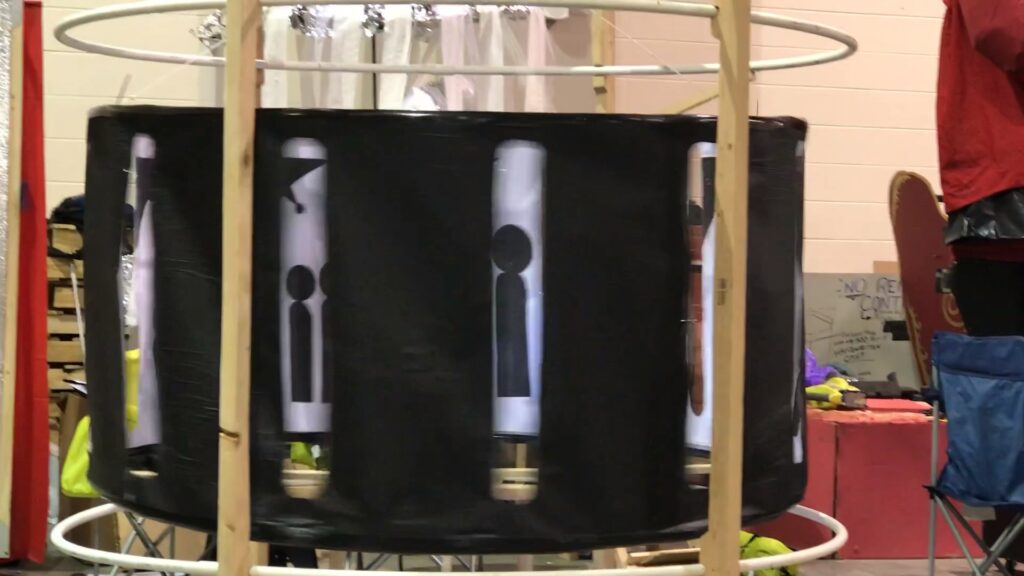
This performance prop was a part of the Maze Craze challenge (see Maze Traveler above). In the beginning of the story, the “Brain Busters” must shrink in order to enter the brain and retrieve the lost memory. The shrink ray is a large-scale zoetrope. When the zoetrope spins, it gives the audience the illusion of the Brain Busters shrinking as they are transported into the brain.
Constructing a Zoetrope on Steroids

The supporting structure of the zoetrope
Four large PVC circles were used. The two larger hoops were connected to the wood frame to serve as an outer boundary. The two smaller hoops served as the skeleton to attach the paper panel with the drawings.

Vertical pieces of wood and horizontal crossbeams provided support for the hoops. This inner “cylinder” was suspended with metal cable from the top of the wood frame.

Images of the “Brain Busters” and the shrink ray were painted onto the inner surface of the paper panel. Each set of images in decreasing size were placed at the appropriate intervals along the panel.

The paper panel was attached to the inner set of PVC pipe circles creating a cylinder with the images facing inward.

The panel had to be securely attached and carefully trimmed so as not to leave loose edges that could snag on any part of the supporting structure.

Finally, slits in the panel were carefully cut out the same distance apart as the images.
Voila!
The Gloomy City on a Hill

This performance prop was part of the Show and Tech Challenge (see Stage and TSJ described above). The scene… a sad, gloomy town in the hills rises in the distance. The mechanical movement of this prop was designed using a rack and pinion system which translates rotational motion (pinion) into linear motion (rack).
Building a Rack and Pinion System


The gear drawing program on woodgears.ca was used to construct wooden gears. Three PVC T-connectors were used to house the gear/rack systems. A single dowel was attached to a motor and turned all three gears. A metal guide was placed inside each T-connector to stabilize the rack.
For the Global Finals performance, a structure was built that supported the town and the rack and pinion system. In addition, the electronics from a remote control car were mounted and allowed the entire prop to be mobile.
Other Technical Challenge Builds
The “Time Machine”
A vehicle with two different propulsion systems
The “Bomb Detector” on the Titanic

A device that can detect objects in sealed containers
The “Mothership”

A vehicle that can travel a specific distance and direction without any outside control
San Joaquin Valley Regional Scholarship Award
As a graduating high school senior, I applied for, and was awarded the San Joaquin Valley Regional Scholarship. My essay describes the impact of DI on me; how it shaped me as a young child through adulthood, and how it will continue to be a positive influence on my everyday life.
I’ll just build a robot… and maybe a shrink ray!” I declared. I still remember the grin on my mother’s face. I was seven years old and at my first team meeting for Destination Imagination (DI). Our challenge: build two mobile machines that work cooperatively to accomplish a series of tasks. Really??? Up to that point, I had never built anything more complex than a Lego car and was still required to use safety scissors. “Ok, now that we’ve decided on a robot, what’s for snack?”
Little did I know, I had taken my first step on a journey that would teach me the creative process – how to think critically, design imaginatively, solve problems effectively, be a productive team member and a leader with a tenacious spirit. These are the gifts of DI, but each gift is not easily received; they are earned through years of practice, hard work, and learning through failure.
Much of my life has revolved around DI; most weekends were spent at team meetings or designing and building. Every September I would eagerly await the release of the new season’s challenges. What would this year’s Technical Challenge be like? Every year brought a new build – a giant boom arm delivering objects over a 10 foot wall, a machine detecting objects in sealed containers, a wheel-less vehicle with two different propulsion systems. Each build brought new opportunities to learn new skills. As my team’s lead technical designer/builder, these builds were my responsibility – especially when things went wrong. I spent many sleepless nights, and a few fire extinguishers, dealing with unexpected mechanical failures.
Fast forward to the 2017 DI Global Finals tournament. We were competing against 65 international high school teams, performing our Technical Challenge solution that won first place at the California state competition earlier that year. Our performance included two huge mechanical devices that elevated and transported us around the stage. When our eight minute presentation time began, one of the power sources malfunctioned. Thinking quickly, I re-routed all of the power through one battery. After losing precious minutes, we began our performance, but later encountered another glitch which prevented us from completing our presentation. My teammate and I were devastated. Completely dejected, we exited the stage. To our surprise, an excited crowd of kids was waiting for us. They wanted us to demonstrate our machines and had hundreds of questions on how they were built. Their enthusiasm helped me through my feelings of failure and showed me you don’t have to be a champion to have a positive effect on others. That night, we attended the awards ceremony, cheering on the other teams being recognized. When the top three teams in our challenge were announced, unbelievably, we were awarded 3rd place! Thanks to the innovative technical design of the devices and the imaginative way we approached the challenge, we overcame the setbacks of our performance. From this experience, I learned that, if you don’t give up, great things can happen. Failure is always an option; it’s how you deal with that failure that can define you.
If you think my goal is to be an engineer, you would be correct, but I am also a dreamer. I see an engineer as someone who can bridge the gap between imagination and reality, and I am on the path to becoming that kind of engineer. DI has taught me that it’s not about the destination, it’s about the journey. And my DI journey has prepared me in more ways than I could have ever imagined. So now, building a robot is a piece of cake… it’s the shrink ray I’m still working on.



